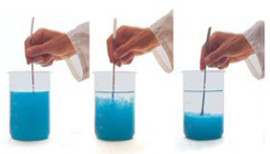Advantages of using Flocculant
- 1. Major Saving in cost.
- 2. Highly enhanced rate of settling of suspended particles in clarifiers, settlers, thickners, sedimentation operations etc.
- 3. Improved clarity of aqueous phase.
- 4. Higher filtration rate on filters, drying beds.
- 5. Higher production rates on sedimentation type centrifuges.
- 6. Generally higher through-put rates on production equipment.
- 7. Low size settling tanks, thickners, filters, centrifuges and hence lower cost of quipment.
- 8. Greatly facilitates primary effluent tratment plants. Simple and low cost plants and operations.
- 9. Extremely useful in treatment of waste waters containing dyes, pigments, pesticides, tannerirs and effluents with high suspended solids.
- 10. Possibility of separation of immisible liquids, water etc. and re-use.
- 11. Selective flocculation of minerals for physical benefication.
- 12. BOD, COD reduction possible.
- 13. Simple and quicker operations.
- 14. 4 to 15 times reduction on size of settling tanks, thickners, clarifiers, etc.
Information about Flocsure Flocculants

By the use of FLOCSURE can make remarkable improvement in solid-liquid separation.
FLOCSURE range of flocculants are available in various grades.
Kindly note that Laboratory tests are essential to choose right grade of flocculant and dosage for your application.

Flocculant can enhance performance of
Settlers, Thickners, Clarifiers, Filters, Drying beds Solid bowl centrifuge system. Air floatation units. Oil recovery units. Effluent treatment plants.

Flocculants dissolve slowly in water.Use of warm water can hasten dissolution. Overnight soaking in water helps in dissolution. FLOCSURE solution of 0.5 to 2 % concentration should be used. Dilute solutions give better results. Dilute Solution of FLOCSURE should be used within 1-2 days. FLOCSURE jelly has shelf life of approx 6 months.

Flocculants can reduce electrical power consumption due to higher through-put from equipment. Too low or high dose of flocculant compared to the optimum can result in poor floc formation.

Positive displacement pumps are recomended for pumping dilute solution of flocculants. Centrifugal pumps should not be used for pumping flocculant solution or flocs.
Vigorous agitation of solution of flocculant or floc should be avoided.
Pumping through small diameter pipelines over a long distance should be avoided.

Prior treatment with Conditioner
Polymer gets attached to solid particles irreversibly. Behaviour of certain solids towards floc formation can be altered by prior treatment with conditioners. In certain cases difficult looking objectives can be achieved by use of flocculants.
 TYPICAL FLOW-SHEET FOR USING FLOCCULANT
TYPICAL FLOW-SHEET FOR USING FLOCCULANT

